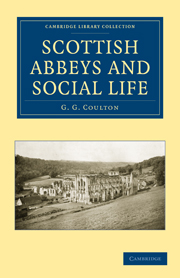Book contents
- Frontmatter
- Contents
- LIST OF ILLUSTRATIONS
- Preface
- Chapter I Celtic Monachism
- Chapter II The Monastic Rules
- Chapter III Monastic Revenues
- Chapter IV How Endowments Came (I)
- Chapter V How Endowments Came (II)
- Chapter VI Monks and Parishes (I)
- Chapter VII Monks and Parishes (II)
- Chapter VIII Charity (I)
- Chapter IX Charity (II)
- Chapter X Monk and Peasant (I)
- Chapter XI Monk and Peasant (II)
- Chapter XII Monastic Housekeeping
- Chapter XIII Church and Scriptorium
- Chapter XIV The Monastic Chronicler
- Chapter XV Schools
- Chapter XVI Art and Learning
- Chapter XVII Professions and Business
- Chapter XVIII Visitation (I)
- Chapter XIX Visitation (II)
- Chapter XX A Voice from the Cloister
- Chapter XXI Conclusion
- Appendixes
- List of Authorities
- Index
Chapter XVI - Art and Learning
Published online by Cambridge University Press: 05 August 2011
- Frontmatter
- Contents
- LIST OF ILLUSTRATIONS
- Preface
- Chapter I Celtic Monachism
- Chapter II The Monastic Rules
- Chapter III Monastic Revenues
- Chapter IV How Endowments Came (I)
- Chapter V How Endowments Came (II)
- Chapter VI Monks and Parishes (I)
- Chapter VII Monks and Parishes (II)
- Chapter VIII Charity (I)
- Chapter IX Charity (II)
- Chapter X Monk and Peasant (I)
- Chapter XI Monk and Peasant (II)
- Chapter XII Monastic Housekeeping
- Chapter XIII Church and Scriptorium
- Chapter XIV The Monastic Chronicler
- Chapter XV Schools
- Chapter XVI Art and Learning
- Chapter XVII Professions and Business
- Chapter XVIII Visitation (I)
- Chapter XIX Visitation (II)
- Chapter XX A Voice from the Cloister
- Chapter XXI Conclusion
- Appendixes
- List of Authorities
- Index
Summary
Here, again, the actual records compel us to go far in discount of current exaggerations.
In art, the monks themselves would be very surprised if they could hear what is often attributed to them. Modern writers generally rely, directly or indirectly, on Montalembert's Monks of the West, which is a panegyric exaggerated everywhere, and on this particular point inaccurate almost beyond belief. Out of the fifty documents upon which Montalembert professes to rely for his statement that the monks commonly built their own churches, only eight are to some extent accurate in special instances, while six say plainly the very opposite of what he claims for them. And, in Scotland, when we happen to have clear documentary evidence, we find that the building or painting or carving is nearly always done by hired workmen, and often by men imported from abroad. This country of exceptional monastic endowments was exceptionally dependent upon foreign artists.
As a characteristic specimen of exaggeration in the past, we may take Cosmo Innes's preface to the valuable Bannatyne Club edition of the Kelso chartulary, page xliii. It runs:
That the arts were cultivated within the Abbey walls, we may conclude without much extrinsic evidence. […]
- Type
- Chapter
- Information
- Scottish Abbeys and Social Life , pp. 187 - 202Publisher: Cambridge University PressPrint publication year: 2010First published in: 1933

